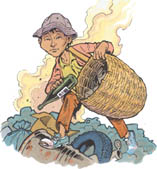Reference Texts
The Consequences of Child Labour

Return to Reference Texts

We propose that the most significant consequence of child labour is the perpetuity of a vicious circle of poverty. One out of every four children in the world is condemned to life as a poor worker with little training.
According to the International Labour Office (ILO), 80% of the 250 million child labourers have neither holidays nor free time, and as many as 50% suffer intolerable working conditions, such as unsanitary locales, harsh treatment, or excessive demands.
The problems include the following:
- Chemicals used in textile, footwear, and jewellery industries, as well as in agriculture are harmful toxins, especially for young children who are still developing.
- Children who scavenge for food and for things to sell often suffer from skin disease and other illnesses caused by poor hygiene. They ingest rotting food, and often handle hazardous garbage. They risk acquiring tetanus from cuts, diseases from rats, and skeletal abnormalities due to heavy lifting.
- The agricultural, fishing, and forestry industries, according to the ILO, account for 70% of accidents and illnesses amongst active children.
- In the leather industry in India and Egypt, children’s feet and hands are continually in contact with chemicals such as ammonia and dyes, and poor air circulation also exacerbates the exposure to such chemicals.

- Children working with glass blowing and foundries spend their youth beside hot furnaces, moulds, and liquid metals and glass, often without any protection.
- In the process of producing matches and fireworks, many children suffer burns, poisoning, respiratory problems, and even death. Squatting for hours at work also provokes joint problems and bone deformities.
- In brick manufacturing in Latin America, children aged 5 and 6 have been employed to carry loads of bricks on their backs or heads. Falls, lower back pain, and fractures are recurring problems where children push wheelbarrows, mix mortar, and climb ladders and scaffolding.
- Lung problems are frequent in children working in bristle and wool mills in Asia.
- Working with poor lighting results in damaged eyesight.
- Work in mines exposes children to hazardous dust, explosive gases, mine shafts that collapse, and lung disease such as silicosis and tuberculosis.
- Sexually exploited children suffer beatings, cigarette burns, and malnutrition. The rate of infection from sexually transmitted diseases is high, and life spans can be drastically reduced. Unwanted pregnancies are also frequent.
- Young soldiers risk their lives and often severe handicaps as well as psychological trauma.
- The destruction of children’s self-esteem can lead to self-destructive habits such as drugs and suicide.
“If children are the future, and they are dieing, there is no more future.”

|